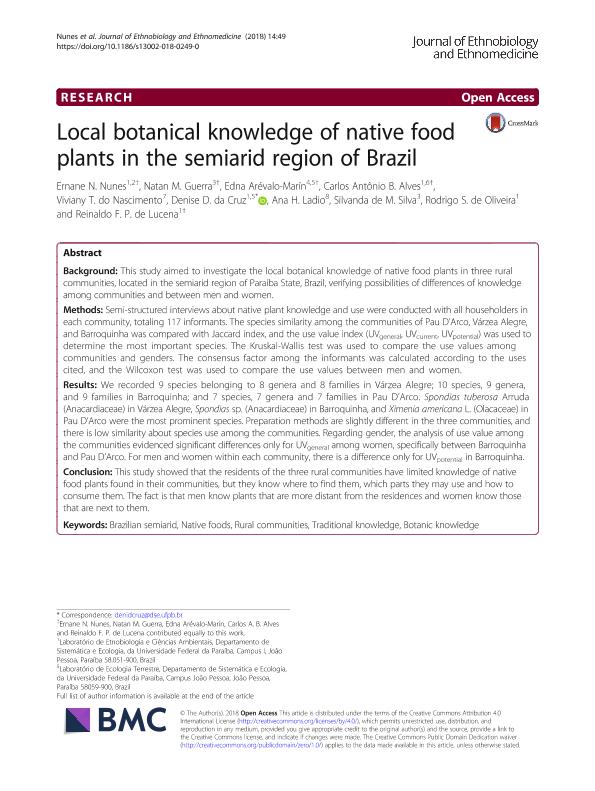Mostrar el registro sencillo del ítem
dc.contributor.author
Nunes, Ernane N.
dc.contributor.author
Guerra, Natan M.
dc.contributor.author
Arévalo Marín, Edna
dc.contributor.author
Alves, Carlos Antônio B.
dc.contributor.author
do Nascimento, Viviany T.
dc.contributor.author
Cruz, Denise Dias da

dc.contributor.author
Ladio, Ana Haydee

dc.contributor.author
Silva, Silvanda de M.
dc.contributor.author
de Oliveira, Rodrigo S.
dc.contributor.author
de Lucena, Reinaldo F. P.
dc.date.available
2019-10-25T21:20:24Z
dc.date.issued
2018-07-20
dc.identifier.citation
Nunes, Ernane N.; Guerra, Natan M.; Arévalo Marín, Edna; Alves, Carlos Antônio B.; do Nascimento, Viviany T.; et al.; Local botanical knowledge of native food plants in the semiarid region of Brazil; BioMed Central; Journal of Ethnobiology and Ethnomedicine; 14; 1; 20-7-2018; 1-13
dc.identifier.issn
1746-4269
dc.identifier.uri
http://hdl.handle.net/11336/87322
dc.description.abstract
Background: This study aimed to investigate the local botanical knowledge of native food plants in three rural communities, located in the semiarid region of Paraíba State, Brazil, verifying possibilities of differences of knowledge among communities and between men and women. Methods: Semi-structured interviews about native plant knowledge and use were conducted with all householders in each community, totaling 117 informants. The species similarity among the communities of Pau D'Arco, Várzea Alegre, and Barroquinha was compared with Jaccard index, and the use value index (UVgeneral, UVcurrent, UVpotential) was used to determine the most important species. The Kruskal-Wallis test was used to compare the use values among communities and genders. The consensus factor among the informants was calculated according to the uses cited, and the Wilcoxon test was used to compare the use values between men and women. Results: We recorded 9 species belonging to 8 genera and 8 families in Várzea Alegre; 10 species, 9 genera, and 9 families in Barroquinha; and 7 species, 7 genera and 7 families in Pau D'Arco. Spondias tuberosa Arruda (Anacardiaceae) in Várzea Alegre, Spondias sp. (Anacardiaceae) in Barroquinha, and Ximenia americana L. (Olacaceae) in Pau D'Arco were the most prominent species. Preparation methods are slightly different in the three communities, and there is low similarity about species use among the communities. Regarding gender, the analysis of use value among the communities evidenced significant differences only for UVgeneral among women, specifically between Barroquinha and Pau D'Arco. For men and women within each community, there is a difference only for UVpotential in Barroquinha. Conclusion: This study showed that the residents of the three rural communities have limited knowledge of native food plants found in their communities, but they know where to find them, which parts they may use and how to consume them. The fact is that men know plants that are more distant from the residences and women know those that are next to them.
dc.format
application/pdf
dc.language.iso
eng
dc.publisher
BioMed Central

dc.rights
info:eu-repo/semantics/openAccess
dc.rights.uri
https://creativecommons.org/licenses/by/2.5/ar/
dc.subject
BOTANIC KNOWLEDGE
dc.subject
BRAZILIAN SEMIARID
dc.subject
NATIVE FOODS
dc.subject
RURAL COMMUNITIES
dc.subject
TRADITIONAL KNOWLEDGE
dc.subject.classification
Ciencias de las Plantas, Botánica

dc.subject.classification
Ciencias Biológicas

dc.subject.classification
CIENCIAS NATURALES Y EXACTAS

dc.title
Local botanical knowledge of native food plants in the semiarid region of Brazil
dc.type
info:eu-repo/semantics/article
dc.type
info:ar-repo/semantics/artículo
dc.type
info:eu-repo/semantics/publishedVersion
dc.date.updated
2019-10-10T13:54:53Z
dc.journal.volume
14
dc.journal.number
1
dc.journal.pagination
1-13
dc.journal.pais
Países Bajos

dc.journal.ciudad
Amsterdam
dc.description.fil
Fil: Nunes, Ernane N.. Universidade Federal da Paraíba; Brasil. Universidade Federal de Campina Grande; Brasil
dc.description.fil
Fil: Guerra, Natan M.. Universidade Federal da Paraíba; Brasil
dc.description.fil
Fil: Arévalo Marín, Edna. Jardim Botânico José Celestino Mutis; Colombia. Universidade Federal da Paraíba; Brasil
dc.description.fil
Fil: Alves, Carlos Antônio B.. Universidade Federal da Paraíba; Brasil
dc.description.fil
Fil: do Nascimento, Viviany T.. Universidade Federal da Bahia; Brasil
dc.description.fil
Fil: Cruz, Denise Dias da. Universidade Federal da Paraíba; Brasil
dc.description.fil
Fil: Ladio, Ana Haydee. Consejo Nacional de Investigaciones Científicas y Técnicas. Centro Científico Tecnológico Conicet - Patagonia Norte. Instituto de Investigaciones en Biodiversidad y Medioambiente. Universidad Nacional del Comahue. Centro Regional Universidad Bariloche. Instituto de Investigaciones en Biodiversidad y Medioambiente; Argentina
dc.description.fil
Fil: Silva, Silvanda de M.. Universidade Federal da Paraíba; Brasil
dc.description.fil
Fil: de Oliveira, Rodrigo S.. Universidade Federal da Paraíba; Brasil
dc.description.fil
Fil: de Lucena, Reinaldo F. P.. Universidade Federal da Paraíba; Brasil
dc.journal.title
Journal of Ethnobiology and Ethnomedicine
dc.relation.alternativeid
info:eu-repo/semantics/altIdentifier/url/https://ethnobiomed.biomedcentral.com/articles/10.1186/s13002-018-0249-0
dc.relation.alternativeid
info:eu-repo/semantics/altIdentifier/doi/http://dx.doi.org/10.1186/s13002-018-0249-0
Archivos asociados
